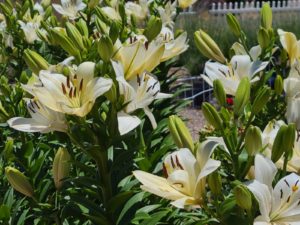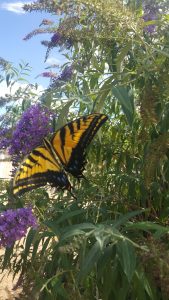 Frost Protection – April 20, 2011 Jeff Schalau, Associate Agent, Agriculture & Natural Resources University of Arizona Cooperative Extension, Yavapai County Winter and early spring frosts can be devastating to ornamentals and fruit crops. The damage can be even more severe in dry years because of plant moisture stress. December and January are the coldest months in the Verde Valley. At the coolest part of the day, the early morning, temperatures routinely fall to the upper twenties and daytime highs reach the sixties. The average first killing frost date in the Verde Valley varies from October 18 to November 25. The last killing frost varies from March 11 to May 8. To understand frost damage, we must remember cold air sinks and warm air rises. During the day, radiant energy from the sun warms the soil surface. At night, this heat is radiated back into the atmosphere. On cloudy nights, the radiated heat from the soil rises to the clouds which reflect the heat back to the earth’s surface. Humidity slows temperature changes. Winds mix the rising warm air and sinking cool air causing a moderation of the cooling effect. During winter, our air is often dry, the air still, and cloud cover absent. These conditions pose the greatest danger of frost damage to plants. Every area has a distinct microclimate and we need to understand it. If you don’t own one already, you should purchase a max/min thermometer. From this inexpensive tool, you can learn much about your microclimate. Take temperature readings in your garden or orchard and record the results. You can also compare your readings with those reported in local papers to determine if your area is warmer or cooler than average. Frost sensitive plants should be planted in sheltered or protected locations. South and west facing slopes capture the greatest amount of radiant energy during the daytime. Large areas of pavement or rock can store heat from the daytime sun then radiate it back to the atmosphere at night. Conversely, fruit trees that tend to blossom too early (apricots, peaches, etc.) should be planted in cooler locations to prolong dormancy and prevent premature bloom. North and east facing slopes are generally cooler. Always keep plants adequately irrigated during cold weather. This will reduce susceptibility to frost damage. Healthy, well acclimated plants will sustain less damage during severe frosts. Weeds, lawns, and mulched areas capture less radiant energy during the day and therefore radiate less heat back to the atmosphere at night. For this reason, it is best to maintain bare, moist, firm soil in fruit orchards. To reduce heat loss at night, you can cover plants with cloth or paper (not plastic). There are products available designed for this purpose. The covering traps some of the heat that radiates from the soil at night. Do not gather the covering around the tree trunk as this defeats the purpose. Rather, let the covering dangle to the ground at the drip line of the canopy. Covers must be removed in the morning and replaced each night that severe frost is expected. If left on, covers can concentrate heat within the canopy during the heat of the day and cause premature break of dormancy. Overhead sprinkling can also reduce frost damage. Ice that forms around buds will maintain a temperature of 32 oF within the bud. This offers a degree of protection if the temperature is much lower than that in the surrounding air. In addition, as water freezes, it releases heat energy during the process thereby warming the surrounding air. Overhead irrigation is not always feasible, but can offer a degree of protection in some cases. What do you do if your plants are frost damaged after you have done your best to prevent it? First, do not prune woody plants until the danger of frost is past and the plant begins growing in spring. Pruning too early can stimulate new growth which would be vulnerable to late frosts. Also, frost damaged leaves and stems will continue to help trap warm air within the canopy on cold nights. Some techniques outlined above are fairly labor and resource intensive. Depending on your individual circumstances, it may be worthwhile to take some of these measures. However, in all cases it is best to provide good care to your ornamentals and fruit trees. Irrigate year round if needed (less in winter). Appropriately fertilize fruit trees, turf, roses, and other plants that display nutrient deficiencies. Use sound cultural practices (pruning, weed control, etc.) and plant the best adapted varieties in suitable locations. Follow the Backyard Gardener on Twitter – use the link on the BYG website. If you have other gardening questions, call the Master Gardener line in the Camp Verde office at 554-8999 Ext. 3 or e-mail us at cottonwoodmg@yahoo.com and be sure to include your name, address and phone number. Find past Backyard Gardener columns or provide feedback at the Backyard Gardener web site: http://cals.arizona.edu/yavapai/anr/hort/by |



No comments.